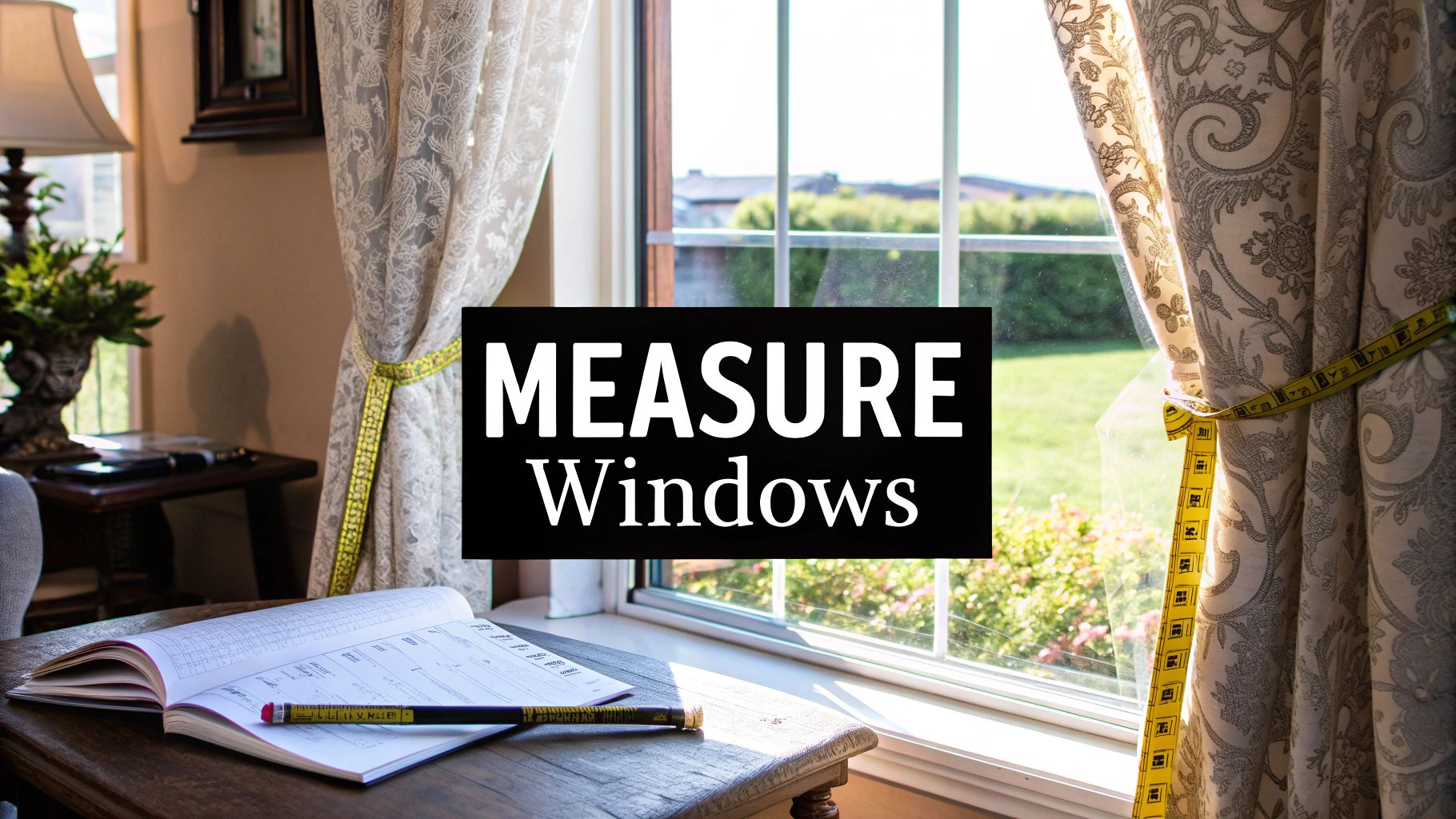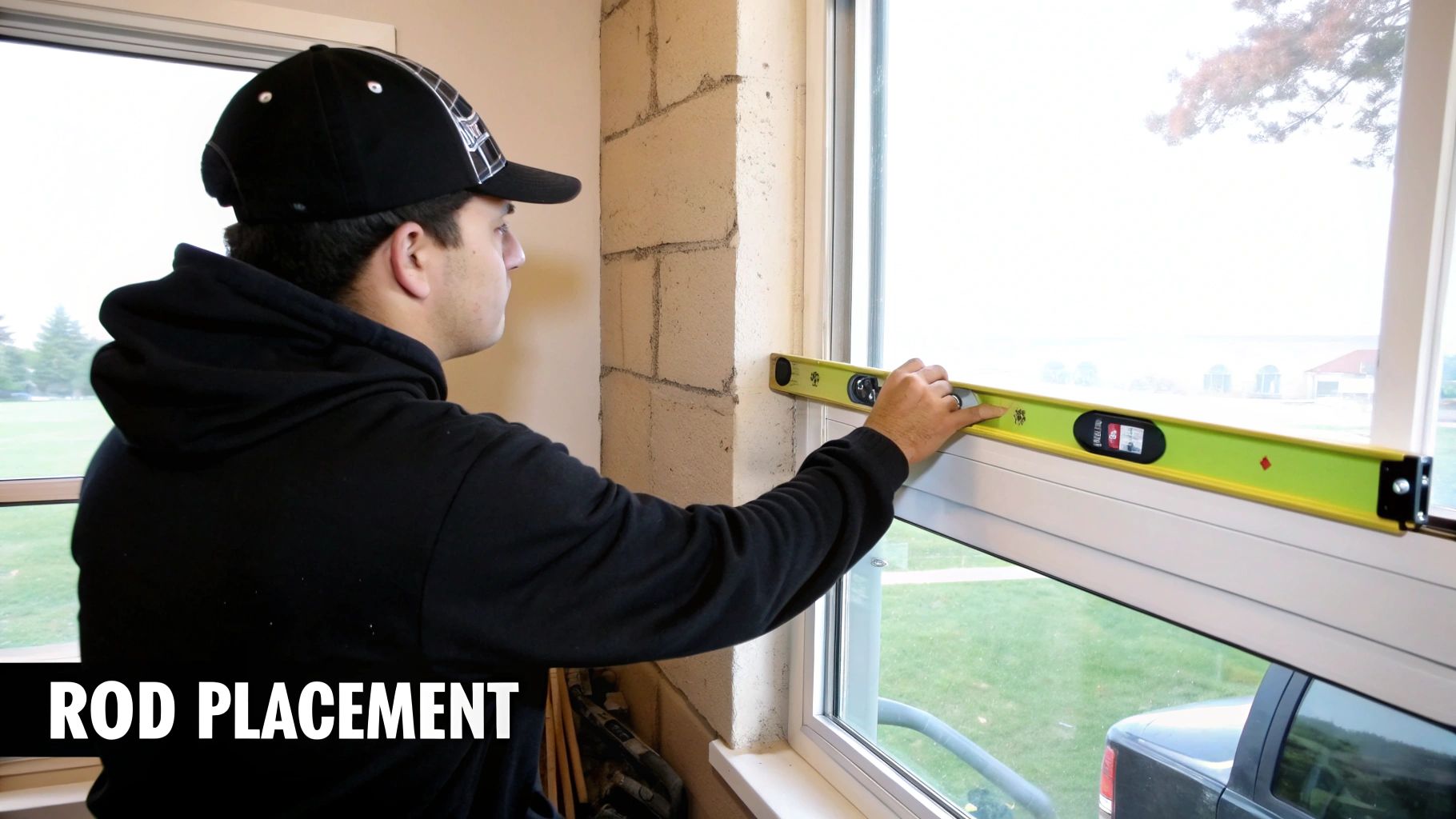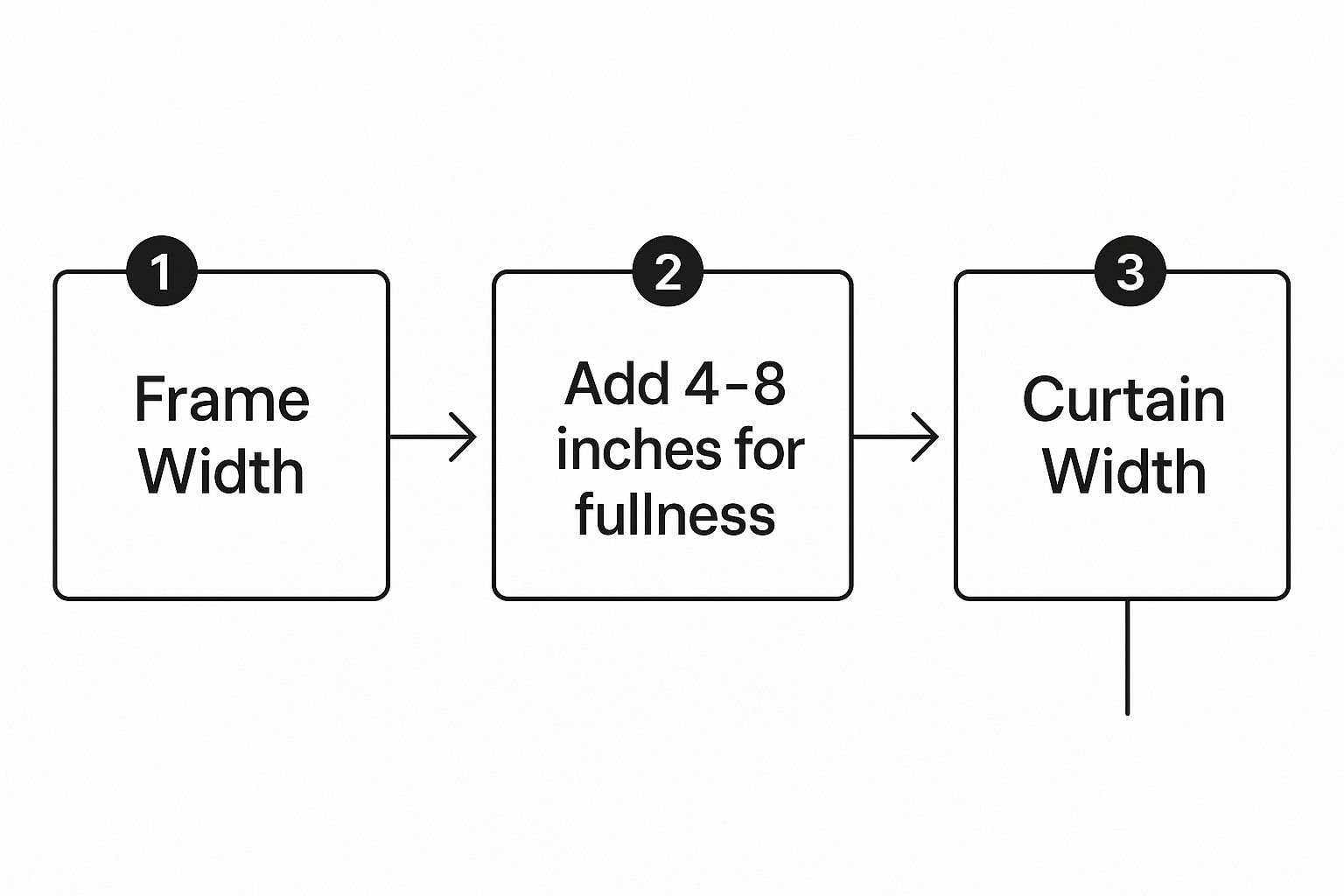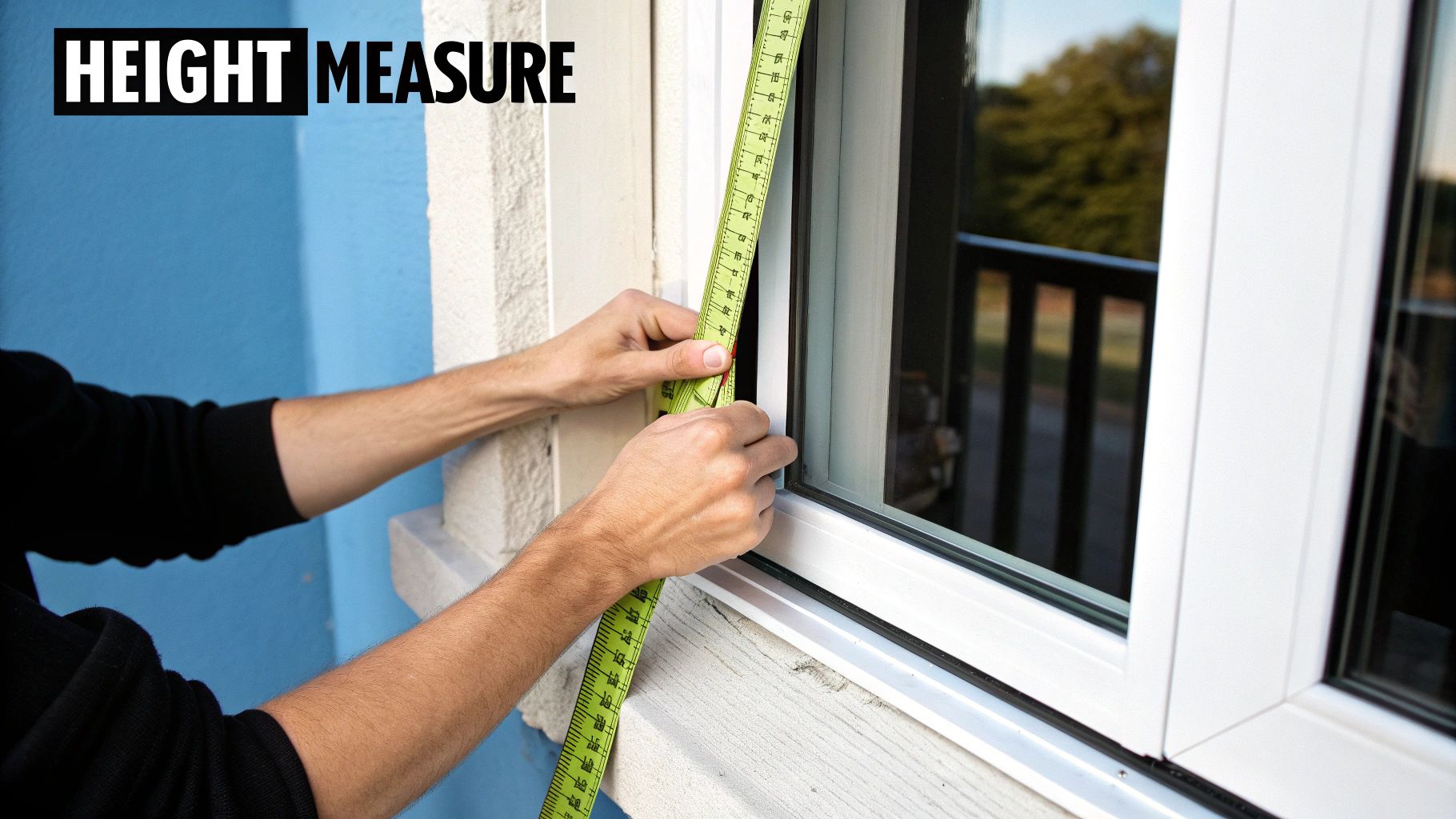How to Measure Windows for Curtains: A Complete NZ Guide

Why Getting Your Window Measurements Right Matters

Let's face it, measuring windows for curtains isn't exactly at the top of anyone's fun list. But skipping this essential step can trigger a domino effect of costly and frustrating issues. Imagine receiving your custom-made curtains, only to find they're too short, leaving an awkward gap above the sill. Or worse, they're too narrow, offering little privacy or light control. These scenarios, unfortunately, are common occurrences in Kiwi homes. Understanding the importance of accurate measurements is the first step towards achieving the perfect curtain setup.
Accurate measurements are the foundation of a successful curtain installation. Getting them right impacts everything from the practical functionality of your curtains to the overall aesthetic appeal of your room.
Correctly measured curtains effectively block unwanted light, ensuring privacy and creating a cozy atmosphere. This is especially crucial in New Zealand, where the sun can be quite intense.
Well-fitted curtains also contribute to energy efficiency by helping to insulate your home. These seemingly small details significantly impact your comfort and well-being.
The Costly Consequences of Incorrect Measurements
Incorrect window measurements lead to more than just aesthetic disappointments. Consider the expense of re-ordering curtains, the inconvenience of returning ill-fitting ones, or the time spent attempting DIY adjustments. These extra costs and frustrations can be easily avoided with careful planning and precise measuring.
Moreover, improperly sized curtains can detract from a room's overall appearance. Curtains that are too short can make windows appear smaller, while those that are too long can look messy and unkempt. According to home decor experts, approximately 70% of New Zealand homeowners choose curtains with standard drop lengths, highlighting the importance of accurate measurements to prevent costly errors. Learn more about measuring for curtains at Curtain Studio. Getting those initial measurements right is paramount.
Achieving a Polished Look
Properly measured curtains not only function well but also enhance a room's style. They beautifully frame your windows, adding a touch of elegance and sophistication. Whether you're aiming for a classic, contemporary, or minimalist look, accurate measurements ensure your curtains hang gracefully and complement your existing decor.
This creates a polished, professional look that elevates the entire space. Taking the time to measure correctly is an investment in both the functionality and the beauty of your home.
Essential Tools and Smart Preparation Strategies

Getting ready to measure for new curtains? Having the right tools and a solid plan can make the whole process much smoother. It's all about gathering a few essential items and taking a methodical approach. This preparation is key for accurate and efficient measuring.
Gathering Your Measuring Arsenal
First, you'll want a metal measuring tape. The rigid metal ensures precise measurements, unlike cloth tapes that can stretch and sag. A small notebook and pen are also crucial for jotting down your measurements as you work. This simple step helps avoid confusion and eliminates the need for re-measuring.
Pre-Measurement Checklist For Success
Just like professional curtain installers, using a checklist can ensure you capture all the necessary dimensions the first time around. Before you even grab your measuring tape, consider these important factors:
-
Inside Mount vs. Outside Mount: Decide if you want your curtains inside or outside the window frame. This choice significantly impacts your measurements. Inside mounts fit within the window frame, while outside mounts hang outside the frame.
-
Existing Window Treatments: Think about any existing blinds or shades. These existing treatments can affect the depth of your window frame, especially for inside mounts.
-
Architectural Features: Pay attention to architectural details like window sills, architraves, or cornices. Features like these can affect curtain length or placement. For instance, a deep window sill might limit how long your curtains can be.
You might be interested in: Top 7 Best Curtain Material for Living Room in 2025 for some great material ideas.
The Power of Double-Checking
Finally, always double-check your measurements. This simple habit drastically reduces errors. Be sure to record your measurements systematically, clearly labeling each window and its dimensions. This extra step ensures you order the right size, saving you both time and money. This careful approach will lead to beautiful and functional window dressings that enhance your home.
Mastering Window Width Measurements Like a Pro

This infographic helps visualize how to determine the right curtain width. It starts with measuring the inside of your window frame and then shows the importance of adding extra width for fullness. Getting the width right is key, not only for coverage but also for how the curtains look when they're open. The infographic demonstrates that simply measuring the frame isn't enough.
That initial measurement is just the beginning. Adding extra width ensures your curtains look great, whether drawn closed or pulled back.
Inside Mount vs. Outside Mount: What's the Difference?
The first step in measuring is deciding on an inside mount or an outside mount. An inside mount means your curtains hang inside the window frame. This creates a clean, minimalist appearance. An outside mount, on the other hand, positions the curtains outside the frame, often covering the architrave.
This can make your windows appear larger and is a good option if your window frames aren't perfectly square. Your choice of mount affects where you'll take your measurements.
Measuring for Inside Mounts
For inside mounts, measure the exact width of your window frame at the top, middle, and bottom. Use the smallest of the three measurements. This will guarantee your curtains fit perfectly inside the frame. This is particularly important in older New Zealand homes where window frames may have shifted over time.
Measuring for Outside Mounts
If you're going for an outside mount, measure the total width you want the curtains to cover. This generally extends beyond the window frame on both sides. Add 15-20cm to each side of the frame. This allows the curtains to stack back neatly without blocking too much light.
It also provides better light control and privacy when the curtains are closed.
The Importance of Fullness
No matter which mount you choose, adding extra width is vital for fullness. Fullness refers to the amount of fabric in your curtains, impacting their drape and overall look. Thin, flat curtains are never a good look! Aim for at least 1.5 to 2 times the measured width for a pleasing, full appearance.
For instance, if your window is 150cm wide, you'll need a combined curtain width of 225-300cm. Data suggests that about 80% of New Zealand homeowners prefer curtains with a combined width of 210cm to 280cm for a pair, a common size for many Kiwi windows. To get this look, accurate measuring and adding at least 600mm for proper stacking is essential. Readymade Blinds offers more information on this topic. This extra fabric ensures beautiful, flowing curtains that enhance your window and the entire room.
Getting Length and Drop Measurements Perfect

Getting your curtain length just right is key for a room that looks and feels great. This seemingly small detail can have a big impact on your windows and the overall feel of the space. A wrong measurement can make a room feel small or unfinished. Let's explore the art of measuring curtain length, from standard drop lengths to perfect fits for New Zealand homes.
Understanding Drop Lengths in NZ
Accurate window measurements are crucial for well-fitting and functional curtains in New Zealand. For instance, CurtainStudio suggests placing tracks a minimum of 10cm above the window. They offer a range of standard drop lengths, including 160cm, 205cm, 220cm, and 240cm, designed to fit most Kiwi homes. These standard sizes simplify curtain selection, particularly for standard-sized windows. However, always double-check with your own measurements.
Choosing the Right Drop for Your Room
Several factors influence the ideal drop length: personal style, room function, and practical aspects. Sill-length curtains are a practical choice for kitchens and bathrooms. They provide easy window access and are less prone to getting dirty.
Floor-length curtains, conversely, offer a more formal and elegant feel. They're perfect for living rooms and bedrooms, adding a sense of height and drama, particularly in NZ homes with high ceilings.
Measuring for Different Drop Lengths
For sill-length curtains, measure from the top of the track or rod down to the window sill. Stop just above the sill to avoid bunching and maintain a clean look.
Measuring floor-length curtains requires a bit more thought. Measure from the top of your track or rod to the floor. Consider whether you want your curtains to kiss the floor, puddle slightly, or float just above. Each style offers a distinct aesthetic. For more helpful tips, check out this guide on how to measure for curtains.
Practical Considerations and Adjustments
Practical elements can impact your length measurements. If you have underfloor heating, add a few extra centimetres to your curtain length. This prevents them from dragging on the floor and obstructing airflow.
Furniture placement also matters. If a sofa or bed sits below the window, adjust the curtain length to avoid interference. Finally, consider cleaning needs. Longer curtains accumulate more dust and may need more frequent cleaning. These are just a few factors to consider when choosing the right drop length for your curtains. By balancing your style with the practicalities of your space, you can select curtain lengths that enhance both the look and feel of your home.
Strategic Track and Rod Positioning for Best Results
The placement of your curtain track or rod significantly impacts both the functionality and aesthetics of your curtains. It's more than just measuring the window; it's about how your curtains interact with the entire room. Strategic positioning is key to maximizing light control, privacy, and the overall visual appeal.
Mounting Options and Their Impact on Positioning
Your chosen mounting style directly influences track or rod placement. You can choose an inside mount, within the window frame, or an outside mount, placed outside the frame. Inside mounts offer a clean, minimalist look and require precise measurements. Outside mounts provide more flexibility, making windows appear larger, a particularly useful trick for smaller windows often found in New Zealand villas. They also offer better light blockage when closed.
Ceiling Height: A Key Consideration
Ceiling height plays a crucial role in track placement. In rooms with higher ceilings, positioning the track closer to the ceiling creates a sense of grandeur and spaciousness, allowing for longer, more elegant curtains. With lower ceilings, mounting the track just above the window frame is often a better choice to avoid overwhelming the room. Finding the right balance is key.
Extending Tracks Beyond the Frame: A Professional Touch
Extending the track beyond the window frame on each side maximizes light and creates the illusion of wider windows. This allows the curtains to stack back fully, revealing the entire window. Custom Curtains, a well-known New Zealand company, recommends extending tracks at least 20cm on each side. They offer various curtain lengths, including sill length (1cm above the sill), below sill length (15cm below the sill), and apron length (150mm below the frame). Explore their website for more insights on curtain sizing. This extra track length not only allows more light but also gives your curtains a more elegant drape.
Dealing with Architectural Obstacles
Architectural features like cornices, light fittings, or deep window sills can present challenges. Careful planning and precise measurements are crucial for a seamless fit. A cornice might require a special bracket to mount the track further from the wall, while a light fitting might necessitate a slight adjustment in track placement.
Achieving the Perfect Look
Strategic track and rod positioning is about maximizing both the beauty and function of your curtains. By considering mounting options, ceiling height, track extensions, and any architectural obstacles, you can achieve a stunning and practical window treatment. This transforms your windows from simple openings to striking design features. The right placement frames the window, controls light and privacy, and contributes to a comfortable and stylish living environment. These details make a big difference in achieving a polished, professional look.
Avoiding Common Measurement Mistakes That Cost Money
Getting new curtains should be an exciting experience, but even seasoned DIYers in Aotearoa can run into trouble with measurements. Small errors can lead to big disappointments and unexpected costs. This section highlights common mistakes Kiwis make when measuring for curtains and offers practical solutions to help you get it right the first time. This saves you both time and money.
Common Mistakes and Their Costly Consequences
Imagine excitedly receiving your new curtains, only to find they're too short, leaving an awkward gap above the window sill. Or perhaps they're too narrow, offering little privacy or light control. Unfortunately, these scenarios are all too common and can result in curtains that look and function poorly.
Such mistakes can lead to expensive re-orders, the hassle of returns, or frustrating DIY fixes. Ill-fitting curtains might require alterations by a seamstress, adding extra costs to your budget. Incorrect measurements can also compromise your home's privacy and energy efficiency.
Double-Checking: Your First Line of Defense
One of the simplest and most effective ways to avoid costly mistakes is to double-check your measurements. It's like proofreading an important email before hitting send – a little extra care upfront can save a lot of trouble later. This simple step can prevent the disappointment and expense of ordering the wrong size.
Learn more in our article about How to measure curtains: Easy step-by-step guide. This guide provides a complete overview of the measuring process.
Common Assumptions That Lead to Trouble
Many homeowners assume their windows are standard sizes or perfectly square. This can be a big mistake. Always measure each window individually, considering any differences in width and height. Even slight deviations can impact how your curtains fit.
Red Flags: When to Re-Measure
If your measurements seem inconsistent or your window frames appear uneven, it's a good idea to re-measure. Trust your instincts. Taking a few extra minutes to confirm your numbers can prevent ordering the wrong size and ensure a perfect fit.
Professional Tips for Measuring Multiple Windows
When measuring multiple windows, be consistent in your approach. Use the same units of measurement (centimeters or millimeters) and label each window's dimensions clearly. This prevents confusion when ordering, especially for larger homes or multiple rooms.
Non-Standard Window Shapes: A Special Case
Bay windows, circular windows, and other unusual shapes require extra attention. Consider consulting a professional for advice on measuring these unique window types. Their expertise can guarantee a precise fit for challenging windows, saving you from the potential headaches of complex measurements.
Professional Measuring Services: When to Consider Them
While measuring windows is a task many can handle, professional help can sometimes be the best choice. If you're unsure about your measurements, have complex window shapes, or want peace of mind, consider professional measuring services. This ensures accuracy and a perfect fit, ultimately saving you time, money, and stress. It's a worthwhile investment, especially for intricate window treatments.
Professional Secrets for Flawless Curtain Measurements
Getting your curtain measurements just right is the key to a polished and professional look. These tips and techniques, borrowed from the pros, will help you achieve a flawless fit every time. It's not just about measuring; it's about building a foundation for curtains that look stunning and function smoothly for years to come.
Industry Best Practices and Quality Checks
Professional curtain installers are sticklers for detail. They know that industry standards are essential for a high-quality finish. Double-checking measurements is a must, ensuring accuracy and minimizing costly mistakes.
Quality control is another key aspect of professional installations. This could involve using a laser level to ensure perfectly horizontal tracks or specialized measuring tools for tricky window shapes. These practices help prevent issues later on.
Navigating Different Window Styles
New Zealand homes showcase a diverse range of window styles, from traditional sash windows to modern sliding doors. Each type presents unique measurement challenges. Bay windows, for instance, require careful consideration of angles and projections. French doors, on the other hand, need precise measurements to ensure they open and close freely. Learn more in our article about curtains.
Tackling Architectural Quirks
Architectural details like cornices, architraves, and deep window sills can add complexity to curtain measurements. Professional installers are skilled at handling these challenges. They often use specialized techniques and hardware, such as extension brackets to clear cornices or custom-made rods for unusual window shapes, ensuring a seamless fit.
To help illustrate standard sizes for New Zealand windows, the table below provides a quick reference guide. It details common window types, standard widths, typical drop lengths, and recommended track extensions.
To help illustrate standard sizes for New Zealand windows, the table below provides a quick reference guide:
NZ Standard Curtain Measurements Quick Reference Comparison of standard curtain sizes and measurements for different window types commonly found in New Zealand homes
| Window Type | Standard Width (cm) | Common Drop Lengths (cm) | Track Extension (cm) |
|---|---|---|---|
| Standard Window | 120-180 | 210, 240 | 10-15 |
| Sliding Door | 180-240 | 210, 240 | 15-20 |
| Bay Window (3 panels) | 240-360 (total) | 210, 240 | 10-15 per panel |
| French Door | 120-180 per door | 210, 240 | 10-15 per door |
This table provides a general guideline. Remember, accurate measurements specific to your windows are always crucial.
Maintaining Clear Communication with Suppliers
Open communication with your curtain supplier is essential. Provide them with precise measurements, including the drop length, track width, and any specific requirements you may have. Clearly stating details like pleat type and heading style ensures the final product meets your expectations.
Planning for the Future
Consider future changes when measuring for curtains. If you plan to add blinds or shutters, factor their depth into your measurements, especially for inside mounts. Thinking ahead ensures your curtains remain functional and beautiful as your home evolves.
Accurate Record-Keeping: Your Essential Checklist
Professionals use comprehensive checklists to stay organized. These lists detail measurements, window types, and specific hardware needs. Clear records ensure everyone involved in the project is on the same page, preventing miscommunication with suppliers. This meticulous approach is vital for achieving the perfect curtains.
Shop now at Maak Home to start your journey towards perfectly measured and beautifully crafted curtains.









